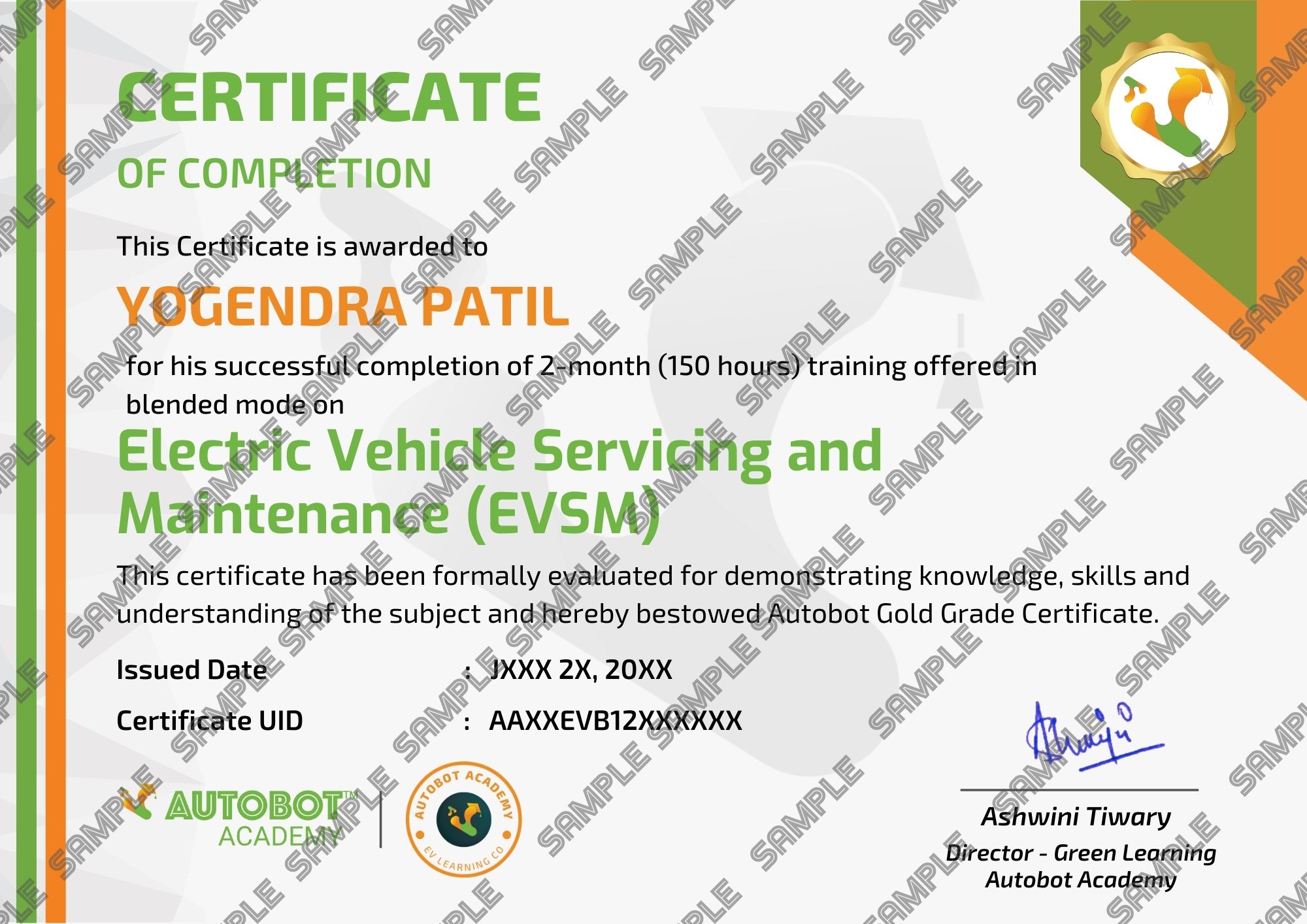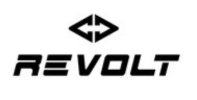EV Engineering: Architecture and Components (EVAC)
Kick-start your EV learning with our OEM recognised course EVAC in collaboration with MG Motor and ASDC.
Call Us:
8860040003
India’s #1 EV technology specialized learning platform in collaboration with
Why we're ranked #1
-
Specialized and Industry FocusedWe’re India's first and only EV technology learning platform which is specialised and offers industry focused certification courses.
-
Technology Learning ExperienceAutobot Learning Studio™ is a unique and powerful tool which offers world class technology learning experience to learners with virtual hands-on experience.
-
Learning Collaborations and RecognitionAutobot Academy offers the widest range of exclusive certification and courses in collaboration with top EV companies with global recognition to learners.
Key Highlights
-
 Learn and collaborate with ALS
Learn and collaborate with ALS
-
 Learn what is not in any textbook
Learn what is not in any textbook
-
 Course is developed by EV experts only
Course is developed by EV experts only
-
 Learn and collaborate with ALS
Learn and collaborate with ALS
-
 Learn what is not in any textbook
Learn what is not in any textbook
-
 Course is developed by EV experts only
Course is developed by EV experts only
- TOP SKILLS THAT YOU WILL LEARN This course offers 360 degrees learning everything about an Electric Vehicle. You will learn about EV architecture, Powertrain selections calculations, Battery & BMS, HV & LV, Power distribution and an overview of the diagnostic and troubleshooting process.
- CAREER SCOPE After Autobot Level 1 certification, candidates confidently may apply for any entry-level job opportunity in the EV industry.
- WHO IS THIS COURSE FOR? This course can be taken by any level of industry professionals (non-EV), entrepreneurs, students and faculty who what to develop the overall knowledge and skill in EV technology.
- MINIMUM ELIGIBILITY Anyone who wants to learn about Electric Vehicles!
Stand out with Autobot globally recognized GRADE certificate and make a distinctive pace in your EV career.
Autobot Grade Certificate is a globally recognized and industry-accepted certificate issued by Autobot Academy in association with Autobot India or other industry partners which is awarded to only qualified learners who complete the course with a minimum of 60 percent throughout the course.
Syllabus
 Introduction to EV
This module talks about the basics of the automobile - the basic requirement for a vehicle to be labelled as an automobile. The various architecture present and their combinations.
Introduction to EV
This module talks about the basics of the automobile - the basic requirement for a vehicle to be labelled as an automobile. The various architecture present and their combinations.
-
Introduction to Automobile
In this video we will discuss about the basic requirement for a vehicle to be termed as an automobile and take a look at the different architecture available currently in the market. And by the end we will study the major components of an electric vehicle. -
History of Automobile
In this video we will journey through time in order to understand the reasons and factors resposnible for coming of EV. -
Current Scenarios
In this video we will look at the trends for last decade and the future predictions in EV industry. Also, discuss about the factors affecting the EV industry. -
Regulatory Norms (Intro to CMVR, AIS, IP ratings)
-
Key Components of EV
 Types of EV and its Architectures
This module starts by mentioning the various types of electric vehicle architecture, currently present in the market.
Types of EV and its Architectures
This module starts by mentioning the various types of electric vehicle architecture, currently present in the market.
-
Types of EV Architectures
-
Parallel Hybrid Vehicle
-
Series Hybrid Vehicle
-
PHEV and BEV
-
Micro vs Mild vs Full Hybrid
-
Mild Hybrid Vehicle
-
Full Hybrid
 EV Powertrain Selection Process
In this module, you will learn, apply and understand the process of how to select the EV Powertrain and various forces that impact its performance and selection process.
EV Powertrain Selection Process
In this module, you will learn, apply and understand the process of how to select the EV Powertrain and various forces that impact its performance and selection process.
-
Forces acting on vehicle
-
Resistive Forces
-
Motor Selection Calculation
-
Single Speed vs Shifter Gearbox in EV
-
Three phase Electrical System
-
Types of Motors (BLDC, PMSM and IM)
-
Motor Selection Challenges
-
Introduction to Powertrain Selection Process
-
Calculation 1: Aerodynamics Forces
-
Calculation 2: Air Resistance Calculations
-
Calculation 3: Flow Around Cone and Sphere
-
Drag Reduction
-
Case Study 1 : Maruti Suzuki Aerodynamics Design
-
Case Study 2: BMW i8 Aerodynamics Design Concepts
-
Motor Selection Methodology
-
Rolling Resistance: Concept of Roll, Slip and Skid
-
Case Study 3: Ather 450x and Nissan Leaf EV Aerodynamics Design
 Electrical Control Unit System
In this module, you will learn about the basics of motor and their control. Various components are involved in the control mechanism, principles of HV and LV components are used.
Electrical Control Unit System
In this module, you will learn about the basics of motor and their control. Various components are involved in the control mechanism, principles of HV and LV components are used.
-
EV Architecture
-
E-Powertrain Components
-
Motor Working
-
DC Series Motor - Working - P1
-
DC Series Motor - Working - P1
-
DC Series Motor - Characteristics
xyz -
Induction Motor - Working
-
Induction Motor - Characteristics P1
-
BLDC Construction
-
BLDC Working
-
BLDC Characteristics
-
Buck Converter
-
Boost Converter
-
Bi-directional Converter
-
DC-AC Converter
-
DC-DC Converter
-
Inverter
-
Current and Voltage Regulation
-
BLDC Controller
-
SPWM
-
Conclusion of E-powertrain
 Energy Storage System in EV
In this module, you will walk through the final stage of electric vehicle design - the battery pack. You will start with various cell types and the parameters to look for while selecting the suitable cell. Following this, you go on to select the battery pack and calculate the cell combination. Now the major concern with the battery pack is safety - hence, comes the BMS. You will look at the basic architectures of BMS available and how to select the suitable BMS for your application. And finally, by the end of the module, you will be able to calculate the range of the battery pack.
By the end of the module, you will also learn about the various recycling processes involved in handling Li-Ion cells.
Energy Storage System in EV
In this module, you will walk through the final stage of electric vehicle design - the battery pack. You will start with various cell types and the parameters to look for while selecting the suitable cell. Following this, you go on to select the battery pack and calculate the cell combination. Now the major concern with the battery pack is safety - hence, comes the BMS. You will look at the basic architectures of BMS available and how to select the suitable BMS for your application. And finally, by the end of the module, you will be able to calculate the range of the battery pack.
By the end of the module, you will also learn about the various recycling processes involved in handling Li-Ion cells.
-
Types of Li-Ion Cells - Shape, size and chemistry
-
ESS Architecture
-
Importance of 12V battery in vehicles
-
Selection of Battery Pack: Cell to Module to Pack
-
BMS Architecture and Function
-
Battery Safety and Thermal Properties
-
Cell Balancing Mechanism
-
Charge and Discharge Characteristics
-
Regenerative Braking System
-
Battery Recycling
-
Power Flow in EV (ZSEV)
-
Why Li-ion Battery?
-
Structure and Comparison of Lithium-ion Battery Chemistries
-
Introduction to Battery Pack
-
Cell Arrangement in a Battery Pack
-
Battery Pack Design Parameters
-
Testing & Validation of Cell & Battery
-
What is Battery Pack?
-
Battery Assembly & Parts
-
Cell & Battery Pack Testing
-
Why BMS?
-
Main Features of Li-battery BMS
-
BMS Block Diagram
-
BMS Class A Architecture
-
Measuring Cell Voltage
-
BMS Topologies
-
Current Measurement
-
Safety Parameters
-
Cell Balancing
-
Fuse Selection
-
Examples of Wire Bond for Battery and BMS - Tesla & Ather
-
Merits & Demerits of BTMS
-
Battery Pack Range
-
Driving Cycle
 Electric Vehicle Charging System
Once the battery pack is clear and you understand the terminologies regarding charging and discharging of the pack, this module will take you through the charging process of the vehicle. We start with types of connectors in the EV and go on to look at the various methods of charging the battery pack in the EV.
Electric Vehicle Charging System
Once the battery pack is clear and you understand the terminologies regarding charging and discharging of the pack, this module will take you through the charging process of the vehicle. We start with types of connectors in the EV and go on to look at the various methods of charging the battery pack in the EV.
-
On Board and Off Board Charging
-
ZSEV Charging Infra awareness
-
Onboard Charger
-
Charging Profile
-
Electric Vehicle Supply Equipment (EVSE)
-
Charging Protocol - Part 1
-
Charging Protocol - Part 2
-
CAN Protocol
-
Automotive Connections
-
Fuse Contractors
-
Relay System
 HV Safety Consideration in EVs
In this module, you will learn about the various constructional and functional safety norms related to HV system handling. You will come to know about various tools and procedures to be followed and IS 26262 standards.
HV Safety Consideration in EVs
In this module, you will learn about the various constructional and functional safety norms related to HV system handling. You will come to know about various tools and procedures to be followed and IS 26262 standards.
-
Introduction to Functional Safety ISO 26262
-
Need of Functional Safety - Basic Overview
-
Need of Functional Safety - Understanding the key functions
-
Functional Safety - HARA
-
Safety Analysis through FTA
-
Functional Safety - Understanding the FMEA
 Diagnostics and Troubleshooting in EV
In this module you will learn about the various handling protocols in an HV system, the components involved and their functionality - we come to this final module where you will learn more about the general errors which are faced in an EV and what are the diagnosis related to that.
Diagnostics and Troubleshooting in EV
In this module you will learn about the various handling protocols in an HV system, the components involved and their functionality - we come to this final module where you will learn more about the general errors which are faced in an EV and what are the diagnosis related to that.
-
What is Diagnostics?
-
Type of Diagnostics errors or Symbol representation
-
Common error and failure types in EV
-
Troubleshooting Methods - Electric Motor Testing
-
Troubleshooting Methods - Inverter Testing
-
Troubleshooting Methods - Remote Diagnostics in EV Drivetrain
-
Next Generation Diagnostics in Servicing in EV
-
Battery in the Cloud
-
Troubleshooting Methods - Predictive Diagnostics
- Overview on EV vs ICE vehicle on architecture, technology and its components
- Calculate torque and power requirement for the vehicle
- Calculate the motor requirements as per the vehicle requirement
- Basic nomenclature of Electric Vehicle technology
- Calculate the battery pack required and cell arrangement
- Perform the selection of suitable BMS topology and architecture for the required application
- Knowledge about the key HV components
- The functioning of HV components
- HV constructional and functional safety protocols
- Detection of basic errors and diagnoses

Industry Mentors and Resources
- Industry mentors, learning resources, personalised learning experience and graders will help you along the way to resolve any subject matters related queries
- They grade your assignments and share one-on-one feedback
Autobot Learning Studio (ALS)™
- More freedom to learn with projects virtually using Autobot Learning Studio anytime, anywhere
- Autobot Learning Studio™ allows learners to take live notes while taking the lectures and stay accessible for a lifetime
Autobot Member Community (AMC)
Community Benefits
- Autobot Certified Members will get lifetime access to AMC.
- Get access to job alerts, trends, and industry insights.
- Opportunity to boost up your credibility in the industry.
- Access to Autobot exclusive knowledge session by experts.
- Lifetime Autobot Forum access for learning, networking, collaborations.




.jpg)






























